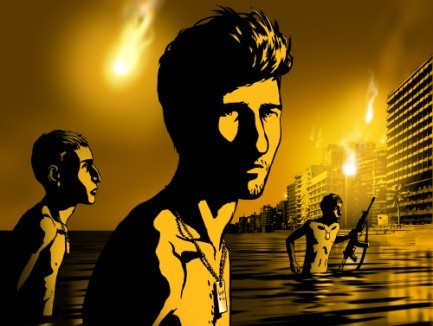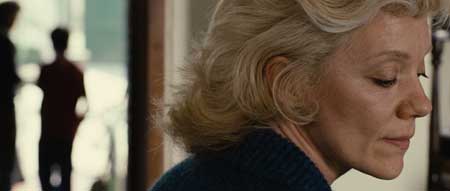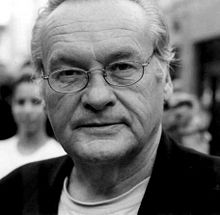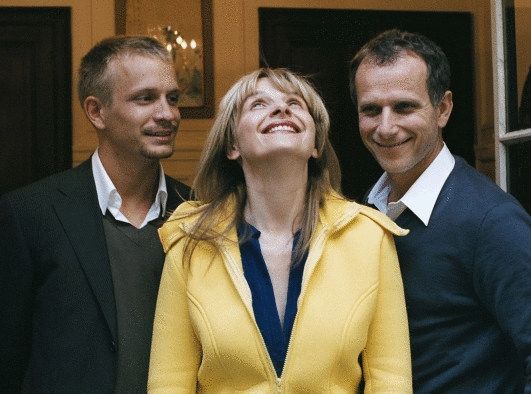
[This is the thirteenth part in an open series of reports from the New York Film Festival.]
About a week ago, fearing that all of the films were turning my mass into flabby mush, I walked two brisk miles in twenty minutes to take in Ari Folman’s Waltz with Bashir, my fourth film of the day. The movie had been described to me by one critic, who purportedly writes for a newspaper, as “a little fiesta” — a qualification that I certainly quibbled with at the time. I’m not sure that a movie depicting the trauma of war and memory can be accurately identified as a “little fiesta.” Certainly, the real-life figures drawn from the Israeli Army do interpret a break between battles as a “little fiesta,” even if they do not precisely use these two specific words. It is true that these soldiers toil in homemade banana leaf huts on the beach and frolic about just before their comrades get shot in their head. But to suggest that these activities represent a “little fiesta” is, I suspect, missing the point just a mite. I’d like to think that the critic in question was having me on, but when I questioned him about specific points in Israel’s history, he had no knowledge of events that went down in 1967.
A professional animator informed me that he had disliked the film because of its gimmick and what he characterized as “amateurish” animation, but this same gentleman had gone bananas over Shuga, a film that I did not care for very much. But it should be observed that the device of a journalist-like protagonist (here, Folman) who questions various people about the meaning of some hazy memory has its roots in Citizen Kane and numerous personal documentaries. I don’t think that Waltz with Bashir is a documentary exactly. It’s more of a recreated narrative with the appearance of an objective pursuit. Something akin to a memoir played out for the camera. Certainly the animation technique, of which more anon, lives up to this notion of reconstruction. If it is not technically successful, then it is certainly viscerally successful.
But I was determined to make up my own mind. My initial reaction after the screening was somewhat ecstatic. But now that it has been a week since I’ve seen Waltz with Bashir, I see the film with slightly different eyes. This is a film that stacks its deck just a bit too heavily. War is bad, and it doesn’t matter what side you’re on. But this predictable rush to condemn war leaves little for the audience to make up their own minds. Paths of Glory is one of the best antiwar films in cinema, but it was Kubrick’s visual genius and his insistence on wiggle room for the audience that made the film work. Waltz with Bashir offers no comparative anthill. It offers more of a sideways glance for a topic that requires thinking in twenty dimensions and more time than you have for rumination. (As Tom Bissell noted in his underrated memoir, The Father of All Things, Vietnam is a subject that one can easily devote a lifetime to.) Waltz is, however, very good about clarifying something just as troubling: more than two decades later, it cannot be stated with any certainty that war memories match up to the reality. (Come to think of it, this is likewise a subject broached by Bissell, and Waltz with Bashir and The Father of All Things might make an intriguing book/movie double bill, or perhaps “two little fiestas” for critics who cloak their ignorance in uninformed mirth.)
The reality itself is the 1982 Lebanon War, and Folman was directly involved. He fought in the Isreali Army and, now in middle age, he retains a memory of naked young men emerging out of the water before a ruined city. Some key friends figure into this fugue: the long-haired Carmi Cna’an, the teenager who everybody figured would succeed in any science, now living in Amsterdam and fiercely protective of his privacy; Shmuel Frenkel, who has taken up vigorous physical exercise and maintains a bald pate; and Israeli war correspondent Ron Ben-Yeshai, who telephoned then-Minister of Defense Ariel Sharon about the massacres at Sabra and Shatila and was given a peremptory answer to back off.
What is quite interesting about Waltz with Bashir is its production method. Folman tracked down the people who haunted his memories, interviewed them, and then styled an animated narrative around these efforts. He even managed to persuade these people to reproduce their voices for the film. (Only a handful of Folman’s subjects declined.)
Each figure appears flat, representing a clear demarcation along a particular focal point. At times, it’s akin to watching a Flash animation or something involving cardboard cutouts from a pre-digital time. Folman’s team has added layers of smoke and reflections atop this basic approach.
Folman also has respect for his subjects’ wishes. When Carmi Cna’an declares that Folman can draw him as he is talking about war, he requests that Folman not include his son. Sure enough, the camera drifts away from the house as Carmi Cna’an engages in this paternal pastime.
But while the testimony that Folman unravels from his subjects certainly inhabits a feel of a bygone time — an atmosphere enhanced by a decent soundtrack and dutiful pop cultural juxtaposition — Folman fumbles a bit on memory’s false starts. Folman’s best friend and shrink, Ori Sivan, brings up a psychological experiment. When subjects were given photographs containing one false element, they believed that the false element was part of the memory. While Folman has exonerated himself somewhat by presenting this caveat to those seeking truth, he nevertheless remains very determined to align his memories to the film’s final moment: a live-action video clip depicting Sabra and Shatila’s aftermath. And while this footage is heartbreaking, with injustices that made me quite angry, I’m not sure if it is entirely fair to corral the film’s theme of ever-shifting memory to this harder reality. If anything, this piecemeal clip presents additional questions about the relationship between documentation and memory that were better pursued in Standard Operating Procedure. This conclusive curveball not only undermines Folman’s thesis and stubs out the strengths of his early emphases, but I suspect that this eleventh-hour departure was why the critic offered me a diabolical conclusion about war being “a little fiesta.”


 Skolimowski: For me, the most important thing is the story. I’m telling the story. And I’m not speculating on what it means more than it is. It’s a story. And of course, one can always find some additional interpretation and some theoretical sightseeing into it.
Skolimowski: For me, the most important thing is the story. I’m telling the story. And I’m not speculating on what it means more than it is. It’s a story. And of course, one can always find some additional interpretation and some theoretical sightseeing into it.